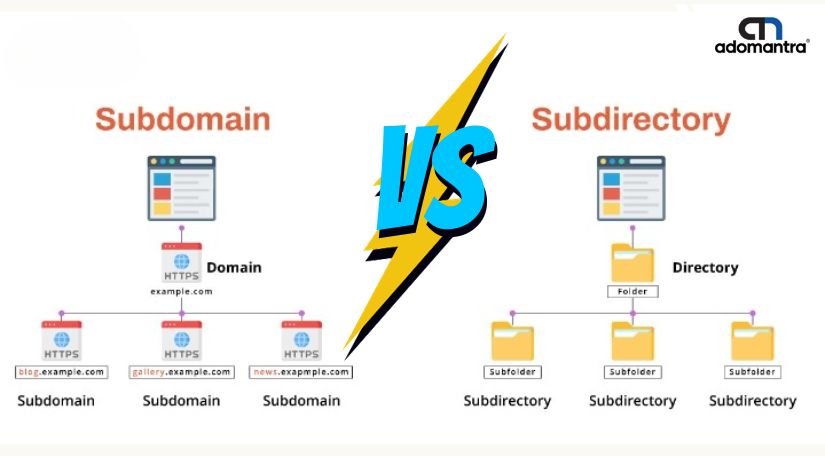
Subdomain vs. Subdirectory: Which is Better for SEO?
In the vast and intricate world of website management, two terms often surface in discussions about website structure and search engine optimization (SEO): subdomains and subdirectories. At first glance, the differences between the two might seem minimal—after all, both serve to organize and categorize the content of a website. Yet, they function in fundamentally different ways. A subdomain, depicted as 'blog.example.com', behaves almost like a separate website, although it's still tethered to the primary domain. On the other hand, a subdirectory, represented as 'example.com/blog/', is more like a folder on your website, housing related content under the umbrella of the main site.
The distinction between the two is not merely academic. From an SEO perspective, the choice between using a subdomain or a subdirectory can have significant implications on your website's visibility, search rankings, and overall digital footprint. As we delve deeper into this topic, we'll unpack the nuances of both and evaluate their respective advantages in the realm of SEO Search engine optimization.
What Is Subdomain?
A subdomain is a subset or a smaller part of a primary domain, allowing organizations and individuals to create distinct web addresses and content without needing to register a new domain name. It essentially functions as a unique website, albeit linked to the main domain. Subdomains are often used to organize or separate content based on distinct functions, audiences, topics, or services.
Structure: In terms of structure, a subdomain appears before the main domain in a URL. For instance, consider the primary domain example.com. A subdomain for a blog on this site might be represented as blog.example.com.
Usage Examples:
- Different Platforms: If a company wants to set up a separate e-commerce platform, they might use
shop.example.com. - Localization: For targeting specific languages or regions, you might see subdomains like
fr.example.comfor French content orus.example.comfor U.S. specific content. - Product or Service Specific Sites: If a company has a particular product or service that they want to highlight or provide specific information for, they might set up
productname.example.com.
Technical Perspective: From a technical standpoint, subdomains can be directed to particular IP addresses, making them useful for distributing web services and applications across various servers. This separation can also be beneficial for security reasons, as a compromise on one subdomain might not necessarily endanger the entire primary domain.
SEO Perspective: From an SEO standpoint, search engines often treat subdomains as separate entities from the main domain, which has both pros and cons. This separation means that any authority or link-building efforts specific to the subdomain won't inherently boost the primary domain's SEO metrics, and vice versa.
A subdomain is a versatile tool for organizing web content, targeting specific audiences, or deploying varied web applications. However, its implications in SEO and web management require careful consideration.
What Is Subdirectory?
A subdirectory, often referred to as a folder, is a hierarchical division within a website, used to organize and store related pages or content under the primary domain. Unlike subdomains, subdirectories do not function as separate websites; instead, they're part of the main website, helping to categorize and structure the content in an orderly manner.
Structure: In a URL, a subdirectory comes after the primary domain. For example, given the domain example.com, a subdirectory for a blog might be structured as example.com/blog/.
Usage Examples:
- Content Organization: If a business offers multiple services and wants to dedicate specific pages or sections to each service, they might organize their content using subdirectories like
example.com/service1/,example.com/service2/, and so on. - Blog Sections: An organization may have different categories for its blog content, leading to subdirectories like
example.com/technology/orexample.com/health/. - Event Pages: For special occasions or annual events, a website might use subdirectories such as
example.com/summit-2023/.
Technical Perspective: From a management perspective, subdirectories are generally easier to set up and maintain than subdomains. They reside within the same hosting environment, share the same SSL certificate, and operate under the same server settings as the primary domain. This streamlined approach can simplify content management and reduce hosting complexities.
SEO Perspective: In the realm of SEO, subdirectories benefit from the cumulative authority of the main domain. This means that if the primary domain has strong SEO metrics, new content in its subdirectories will typically start with an advantage in search engine rankings. Conversely, any positive link-building or content efforts within a subdirectory can boost the overall authority of the main domain.
To sum it up, a subdirectory is an integral part of the primary website, primarily used to classify and systematize content. Its interconnected nature with the main domain makes it a favorite for many SEO professionals when aiming to consolidate domain authority and simplify content management.
What is the difference between a subdomain and a subdirectory in SEO?
When considering SEO, the choice between subdomains and subdirectories can have notable implications for a website's performance in search rankings. Let's explore the primary differences between the two in the context of SEO:
-
Search Engine Perception:
- Subdomain: Search engines often view subdomains as separate entities from the main domain. This means that
blog.example.commight be treated as an entirely different website fromexample.com. - Subdirectory: Subdirectories are seen as a part of the primary domain. All the content under
example.com/blog/is perceived as part ofexample.com.
- Subdomain: Search engines often view subdomains as separate entities from the main domain. This means that
-
Domain Authority and Link Equity:
- Subdomain: Since it's often treated as a separate website, a subdomain does not inherently benefit from the domain authority of the primary domain. Any link-building efforts or authority gained by the subdomain usually don't translate directly to the main domain.
- Subdirectory: The content within a subdirectory benefits directly from the main domain's authority. Similarly, any positive SEO efforts within a subdirectory can amplify the overall authority of the primary domain.
-
Content Management and Hosting:
- Subdomain: Can be hosted on a different server than the main domain, allowing more flexibility in terms of hosting configurations and management.
- Subdirectory: Resides on the same server as the main domain, simplifying hosting and server management.
-
SEO Strategy and Consolidation:
- Subdomain: Requires a separate SEO strategy, as search engines might rank it independently from the main domain. This can be beneficial if you want to target a different audience or market but requires additional effort to build its SEO authority.
- Subdirectory: Benefits from a consolidated SEO strategy with the primary domain, making it easier to boost overall rankings and visibility.
-
Usability and User Perception:
- Subdomain: May be perceived as a distinct entity from the main website, which can be advantageous if you want to create a unique brand identity or user experience for a specific product, service, or audience.
- Subdirectory: Seamlessly integrates with the main website, offering a cohesive user experience.
while both subdomains and subdirectories have their own set of advantages and use cases, the choice often boils down to your SEO objectives. If you want to consolidate authority and simplify content management, subdirectories are typically favored. However, if you need a distinct presence or wish to segregate specific content or functionalities, subdomains might be the way to go.
Pros of Using Subdomains for SEO:
-
Branding for Specific Product Lines or Services:
- Detail: Subdomains allow businesses to create distinct branding experiences for different product lines or services. For example, a company with diverse offerings can highlight each one separately (e.g.,
mobile.example.comfor mobile products andfashion.example.comfor clothing lines).
- Detail: Subdomains allow businesses to create distinct branding experiences for different product lines or services. For example, a company with diverse offerings can highlight each one separately (e.g.,
-
Tailored User Experiences for Different Audiences:
- Detail: Different subdomains can provide specific user experiences based on audience segments. For instance,
community.example.comcould have a different layout and features than the main website, enhancing engagement for community members.
- Detail: Different subdomains can provide specific user experiences based on audience segments. For instance,
-
Potential for Hosting on Different Servers:
- Detail: Technically, subdomains can be hosted on different servers, offering flexibility in terms of server configuration, load balancing, and optimization. This can be particularly beneficial for large organizations or those with specialized technical requirements.
Cons of Using Subdomains for SEO:
-
May be Seen as Separate Entities by Search Engines:
- Detail: One of the most discussed drawbacks of subdomains is that search engines might treat them as separate entities from the main domain. This separation means that the authority and trust established for the primary domain might not automatically extend to the subdomain, making it potentially harder for new subdomains to rank well initially.
-
Requires More Extensive Link-Building Efforts:
- Detail: Given the potential separation from the main domain, SEO professionals might need to invest in additional link-building efforts for each subdomain. Links that point to a subdomain might not pass as much authority to the main domain, and vice versa.
-
Additional Management for SSL Certificates:
- Detail: While wildcard SSL certificates can cover subdomains, if different SSL certificates are used, it necessitates additional management. This can complicate the process of ensuring that all parts of a website are securely accessible and trusted by browsers.
while subdomains offer flexibility, branding opportunities, and tailored user experiences, they also come with challenges in terms of SEO strategy, link equity distribution, and technical management. Each organization must weigh these pros and cons against their specific needs and resources.
Pros of Using Subdirectories for SEO:
-
Consolidates Domain Authority as All Content is Under One Domain:
- Detail: One of the primary advantages of using subdirectories is the natural consolidation of domain authority. Any positive SEO efforts (like link-building) for content within a subdirectory boost the primary domain's authority and vice versa.
-
Simplifies User Experience with One Unified Website:
- Detail: With subdirectories, users experience a consistent look, feel, and navigation since all content feels inherently connected. This can lead to increased trust, lower bounce rates, and a cohesive brand experience.
-
Easier Content Management:
- Detail: Subdirectories typically require a single content management system (CMS). This streamlining can make it easier to manage, update, and publish content without juggling multiple platforms.
Cons of Using Subdirectories for SEO:
-
Potential for Content Dilution if Not Structured Well:
- Detail: If there's a broad range of topics or categories housed under a single domain without a clear structure, it can confuse search engines and users alike. This lack of clarity can dilute the focus of the site and impact its perceived relevance on certain topics.
-
Might Become Messy if There's a Lot of Diverse Content:
- Detail: If a website serves multiple distinct purposes (e.g., e-commerce, forum, blog, and more), housing everything under one domain might lead to a complicated URL structure. This can make it harder for users to intuitively navigate the site and for webmasters to organize and prioritize content.
-
Less Flexibility in Technical Configurations:
- Detail: Unlike subdomains that can be hosted separately, all subdirectories are hosted on the same server. This can limit the ability to optimize different sections of the site with specific server configurations.
In essence, subdirectories can be a boon for sites looking to capitalize on existing domain authority and offer a streamlined user experience. However, they do come with challenges, especially when dealing with diverse and expansive content. As always, the decision should be based on the specific goals and structure of the website.
What Are The Importance Of subdomain and a subdirectory in SEO?
Both subdomains and subdirectories play significant roles in SEO, each offering unique advantages depending on the goals of a website. Their importance in SEO revolves around content organization, domain authority distribution, and targeted audience reach. Here's a detailed look at the importance of each:
Importance of Subdomains in SEO:
- Audience Segmentation: Subdomains allow websites to target specific audience segments. For example, a global brand can use geographically specific subdomains like
us.example.comanduk.example.comto cater to audiences in different regions. - Niche Branding: Brands with multiple products or services can establish a unique identity for each offering. For instance, a company might have
shop.example.comfor its online store andcommunity.example.comfor its user forum. - Technical Flexibility: Subdomains can be hosted on different servers, allowing businesses to optimize each subdomain's server configuration based on its specific needs. This flexibility can be crucial for performance optimization and load balancing.
- Risk Isolation: If one subdomain is compromised, it might not directly endanger the primary domain or other subdomains. This separation can be crucial for security and risk management.
- Independent SEO Strategy: A subdomain can have its own SEO strategy, which can be tailored to its content, audience, and objectives, separate from the main domain.
Importance of Subdirectories in SEO:
- Domain Authority Consolidation: All content within subdirectories benefits from the primary domain's authority. As such, it's generally easier to rank new content within a subdirectory on an established domain.
- Simplified Management: Managing content, SSL certificates, and server settings is more straightforward with subdirectories, as everything resides under the main domain.
- Unified User Experience: Subdirectories allow for a seamless user experience as all content feels like part of the primary website. This consistency can boost user trust and engagement.
- Cohesive SEO Strategy: With all content under one domain, it's often simpler to have a unified SEO strategy. This cohesiveness can simplify tracking, analytics, and optimization efforts.
- Efficient Crawling: Search engine crawlers often find it easier to discover and index content organized in subdirectories, especially if a clear sitemap is provided.
The importance of subdomains and subdirectories in SEO lies in their ability to cater to specific needs and objectives. Subdomains offer independence and flexibility, making them suitable for distinct branding or audience segmentation. On the other hand, subdirectories allow for authority consolidation and streamlined management, making them ideal for building upon an existing domain's strength. The choice between the two should be based on a website's goals, audience, and content strategy.
What Does Google Say About Subdomains vs. Subdirectories?
- They are Treated Similarly, But Not Always the Same: Google's algorithms can usually differentiate between subdomains and subdirectories. Historically, Google might have treated subdomains as separate entities, but advancements in their algorithms mean they now often recognize subdomains as part of the main domain. However, this isn't always the case, and there can be situations where subdomains are treated as separate sites.
- Focus on Content, Not Structure: Google emphasizes that webmasters should focus more on delivering quality content than on the debate between subdomains and subdirectories. Both structures can rank effectively if they contain relevant, authoritative, and valuable content for users.
- Consolidation of Signals: Google's John Mueller, a Webmaster Trends Analyst, has mentioned in various webmaster hangouts that Google tries to consolidate signals for subdomains and the main domain. So, if you have multiple subdomains, Google will attempt to understand and consolidate the signals, but it's not always perfect. In contrast, subdirectories naturally consolidate signals under the primary domain.
- Technical Considerations Matter: Google has also highlighted that webmasters might choose subdomains for technical reasons. For instance, different teams managing different parts of a business might find it easier to work with subdomains. In such cases, Google's algorithms aim to understand the broader domain's structure to provide the most relevant search results.
- Localization and Geo-Targeting: For businesses operating in multiple countries or languages, Google does offer the ability to set geo-targeting for subdomains independently in Google Search Console. This can be handy if you're using subdomains for different countries or languages.
While Google has made strides in understanding and effectively indexing both subdomains and subdirectories, the decision between the two should be based on organizational, technical, and content needs. SEO considerations are essential, but they are just one factor in the broader decision-making process. As always, Google's primary advice revolves around creating high-quality content and a great user experience, regardless of the specific URL structure chosen.
Factors to Consider When Choosing Between Subdomains and Subdirectories
Type of Content:
-
Detail: The content's nature and how it relates to the main site is crucial.
-
Subdomain: If you're launching a platform that offers a significantly different user experience or content type than your main site (e.g., an e-commerce site branching out into a user forum), a subdomain may make sense.
-
Subdirectory: For content closely related to the main website, such as blog posts, product categories, or service listings, subdirectories might be more suitable to maintain cohesiveness.
-
Target Audience:
-
Detail: Who you're targeting can dictate your structure choice.
-
Subdomain: If you're catering to an entirely different audience or launching in a new geographic region, subdomains can help tailor the experience to that demographic. For instance, a multi-language site might use
fr.example.comfor its French audience. -
Subdirectory: If your additional content targets the same audience as your primary site, using subdirectories can keep the user experience seamless and familiar.
-
Website Management:
-
Detail: Technical considerations, including hosting arrangements, often influence the choice.
-
Subdomain: If different teams manage parts of your website and they require separate hosting environments or server configurations, subdomains can provide that flexibility.
-
Subdirectory: If the same team manages all content, and you're using a singular hosting setup, then subdirectories can simplify management, maintenance, and scaling.
-
Branding Needs:
-
Detail: The need for distinct branding or identity can sway the decision.
-
Subdomain: If a segment of your offerings requires its branding, like a unique product line or a special campaign, subdomains can help establish that separate identity.
-
Subdirectory: For brands that want to maintain a singular, cohesive identity without fragmenting their brand image, subdirectories are the way to go.
-
Conclusion
In the grand scheme of website structuring, the debate of "Subdomain vs. Subdirectory: Which is Better for SEO?" remains at the forefront of digital strategy discussions. The decision isn't black and white, as both choices come with distinct advantages and considerations. A subdomain may offer unparalleled flexibility and branding opportunities, especially when catering to diverse audiences or content types. On the other hand, a subdirectory inherently benefits from consolidated domain authority and offers a unified user experience, making content management more straightforward. As the digital landscape evolves, it's essential for website owners and marketers to adapt. The focus should not merely be on following a one-size-fits-all approach but on analyzing individual website goals, target audience needs, and technical capabilities. In the end, whether you opt for a subdomain or a subdirectory, the key lies in delivering valuable, relevant content that meets user needs. Only by intertwining sound structural decisions with quality content creation can one truly optimize for SEO success. while technology and algorithms play their part, it's the unique content creator's touch that leaves an indelible mark in the vast digital realm. So, as you weigh the pros and cons of subdomains and subdirectories, ensure that originality and authenticity remain at the heart of your digital endeavors.







